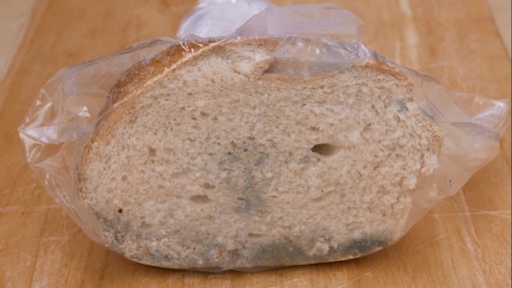2 Your bread mold experiment and yeast
How did you get on with your bread experiment from Week 2 [Tip: hold Ctrl and click a link to open it in a new tab. (Hide tip)] ? Did you take some photographs over the days which showed the growth of mold?
In case you were unable to do it, we also carried out this experiment. Watch Video 2, which shows how a loaf of bread changes over several days.

You can see that, as the mold starts to grow and spread, bubbles of gas and liquid form in the plastic bag containing the bread. This plastic bag then starts to collapse in on the loaf of bread.
In Section 1, you met the term fungi (singular: fungus). Fungi are carried in the air as spores. When these spores land on bread, they germinate and start to grow as a fungus.
-
What does this fungus need to grow?
-
It needs a food source (the bread) and an environment containing moisture. Humidity is the amount of water vapour in the air, so it’s now definitely worth watching the weather forecasts!
-
What happened to your bread? Why does it change? Would you have believed that the environments you chose had moisture in the air? But why does the bread change?
-
It goes through a chemical change. The mold ‘eats’ the sugar, water and minerals in the bread. At the same time, another chemical change takes place: the bread is decomposing. As a result of both of these changes, gases are emitted and heat is produced.
In Week 2, you saw how research in a microgravity environment is key to establishing how space can affect astronauts’ health. Are you wondering how your bread experiment and fungi are relevant to a microgravity environment? Well, in your experiment, you saw how mold is gradually created over a period of time. In space, it has been found that yeast cells, from bread, grow much more quickly than on Earth. But why is yeast a good organism for research in a microgravity environment? Read this article on microscopic astronauts (NASA, 2007) to find out and then complete Activity 3.
Activity 3 Yeast in a microgravity environment
Choose the correct options to complete the following statements.
a.
withheld
b.
partially mapped
c.
completely mapped
d.
unmapped
The correct answer is c.
a.
humans
b.
bacteria
c.
microbes
d.
dogs
e.
monkeys
The correct answer is a.
You will now look at ‘space bugs’.
